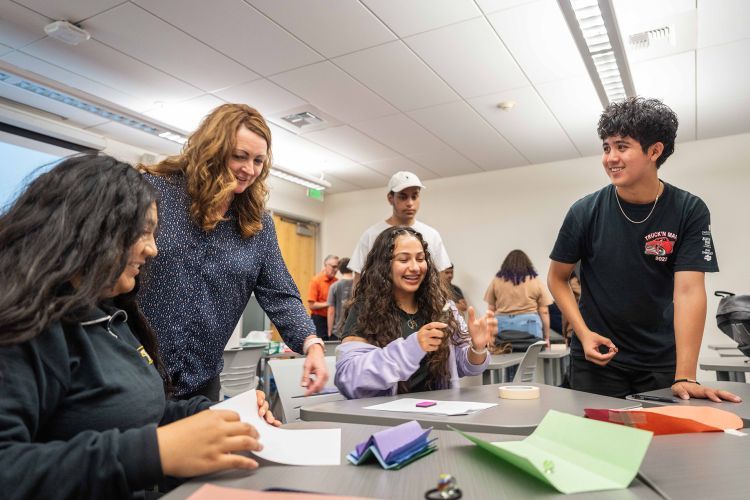Pacific pilot program provides opportunities for aspiring college students
Ashley Williams
December 10, 2023
University of the Pacific opened its classroom and laboratory space to some of the Stockton area’s top high school students during a pilot engineering course, allowing them to earn college credit while exploring future areas of study.
On Wednesdays during fall term, 25 students from Aspire Benjamin Holt College Preparatory Academy and Aspire Langston Hughes Academy, both Stockton schools, attended the Introduction to Engineering class at the John T. Chambers Technology Center on the Stockton Campus. The one-unit college class was taught by School of Engineering and Computer Science Dean Elizabeth Orwin, who brought in other faculty and staff leaders to illustrate different areas of engineering.
“Many students do not know a lot about engineering, but they are intrigued by the concepts,” Orwin said. “We are introducing them to the engineering design process and to the various disciplines, such as civil, mechanical, computer engineering and more.”
Anthony Solina, executive director of Aspire Public Schools of the Central Valley, emphasized that students benefit from being around academic excellence, including Pacific’s engineering and computer science programs, where more than 90% of students have a job awaiting them at graduation.
“They see more than potential careers; they see career pathways—answers on how they can get to where they want to go,” he said. “With the guidance they received at Pacific, many are now looking to go into engineering, and they are doing so with confidence.”
I am now 100% firm that I want to major in STEM. This is the class that made me want to be an engineer.
– Angel Perez, student
On December 6, family members, high school officials and others gathered at the Don and Karen DeRosa University Center to watch students showcase their final projects during the Pacific Pilot Showcase and Celebration.
Students worked in teams and the assignment for each was to construct a paperweight advertising engineering at University of the Pacific that could be given to prospective students or donors. Many teams worked Power Cat, Burns Tower or other notable Pacific icons into their designs.
“We worked as a team, and that was a great experience. I have never been so infatuated with academia as I was with this Pacific class,” said Angel Perez, a Langston Hughes student. “Every time I went to class it seemed like I learned how something works and why it works. I am now 100% firm that I want to major in STEM. This is the class that made me want to be an engineer.”
Diorue Hodges, a fellow Langston Hughes student, said the course also shifted her career plans to engineering.
“I always wanted to be a nurse or a doctor, and I didn’t even think of engineering as a career pathway,” Hodges said. “I was exposed to the thinking behind engineering and it changed everything. There are low levels of women, particularly Black women, in STEM and engineering and I want to be an inspiration for leading others into the field.”
The percentage of women in the field is estimated at 25%. Dean Orwin’s goal is to raise that to 50% in the School of Engineering and Computer Science.

Twenty-five students attended the one-unit college course taught by Dean Elizabeth Orwin.
The class provided students with hands-on experience. During one session, assignments included dissecting and rebuilding sheep eyeballs. Students also worked in teams to build make-shift pinball machines and shoot for a specific time—eight seconds—for the pinball to reach its destination.
Dario Preciado, a student at Benjamin Holt Academy, proved adept at dissecting the eyeball with guidance from Orwin, whose research focuses on the study of the cornea.
“It felt squishy, which is about what I expected,” he said. “We are trying to learn what engineers do. I personally am considering what I would like to study, so I am trying out different things.”
Alejandro Guerrero and Jazmyn Corona of Benjamin Holt Academy were on a five-person team that worked on the pinball challenge. Using cardboard, tape and propping a desk up with textbooks, they built a pinball course and tested it dozens of times.
The team’s best effort was 8.08 seconds.
Provost and Executive Vice President for Academic Affairs Gretchen Edwalds-Gilbert said she is pleased to have the students on campus and eager to adapt what is learned from this pilot for use in other fields of study.
“Coming to campus is a key component of the model since students have the semester to get comfortable in class,” she said. “Collaborating with the high schools on students’ needs and interests is also important. We hope to see offerings across disciplines as we move forward.”
Another engineering course is set for the spring semester and Pacific administrators have contacted school officials to discuss similar courses in other disciplines. Pacific is exploring courses in teaching and education, business, digital media, sustainability, health sciences, computer science, sports medicine, anatomy, kinesiology, sports analytics, sports management, music industry, pre-health and pre-law.
For more information on Pacific college-credit courses for high school students, contact Ashley Williams at awilliams4@pacific.edu.